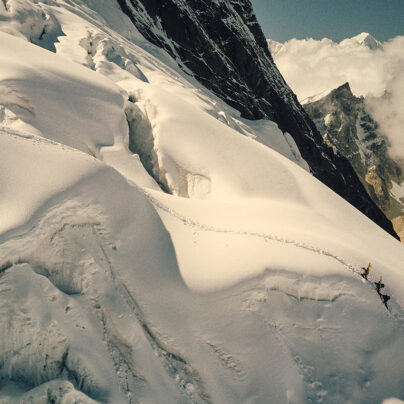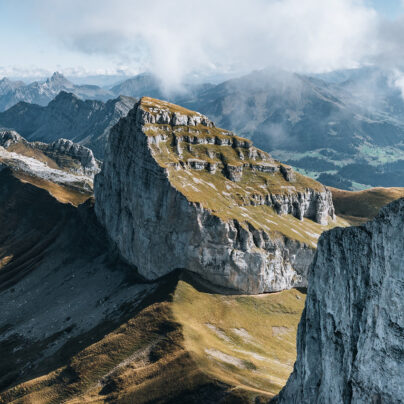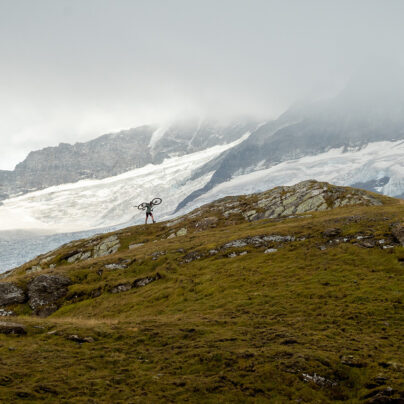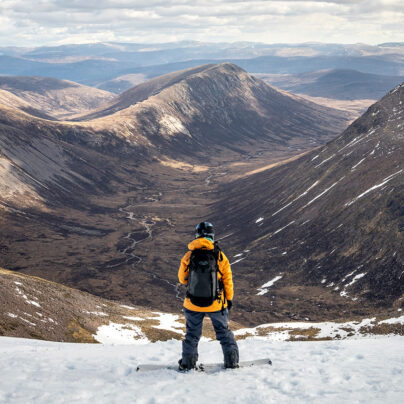Close Encounters
Words & Photography by Ana-Maria Pavalache
In the dark, I took in a long breath and almost heard my thoughts out loud. Late at night, late in so many ways, but after eight years, I was finally here.
Khurdopin Glacier, July 5th
It was well into night when I reached the remote valley of Shimshal, 3,100m above sea level, after a two-day drive over precarious, dusty mountain roads. In the dark, I took in a long breath and almost heard my thoughts out loud. Late at night, late in so many ways, but after eight years, I was finally here.
Delayed by bad weather around K2, I hadn’t been able to join the research team on the Khurdopin Glacier for their anticipated fieldwork. I could only imagine the challenges the team had faced as Sergiu and I were the only ones with significant mountaineering experience. Jeremy and Ronald, although excellent trekkers, lacked the technical skills to tackle the complex terrain on the Khurdopin Glacier and I wondered if they had been forced to remain at base camp – or, worse, had gone on and attempted to cross the very difficult glacier. The climbing season had already started and I knew that there would be a shortage of porters in the valley. Fortunately, a Pakistani guide I had recently met in Skardu managed to find a middle-aged man, Amir, who agreed to join me the next morning. Midnight came and, after finalising the remaining details, I had five hours to sleep and repack food and camping gear for the coming fortnight. I needed to get to my team.
Our labours began early the next day, July 6th, before dawn. Labours in the form of the 27km we’d need to put behind us before we reached Past Helga (3,479m), our first camp. We broke for tea after crossing the arid terminal moraine of the Yazghil Glacier. We hadn’t expected such high summer temperatures. Ahead lay another nine or so kilometres of the lowest section of the debris-strewn Khurdopin. After my experiences on Biafo and Baltoro, I had hoped traversing this portion would be easier. I was wrong. Our progress was slow, overwhelmed by crevasses, shifting debris, and attenuated ice cliffs. ‘A complete hell to cross,’ Sergiu would later say of his own experience. I’d never seen a glacier more alive. A cool light spilled onto the snowy peaks above, among them Yukshin Gardan Sar, which Sergiu had attempted to climb in the summer of 2015. By early evening, Amir and I were exhausted and knew there was no way off the glacier before nightfall. We set up camp between two giant boulders of ice. There were no chapati or spicy Pakistani dishes, only dehydrated quinoa, beans, and chickpeas. The arid, frozen wind swirling off the glacier made the night feel long and cold. My guilt at being late only made the wind’s bellow seem more oppressive.



My mind wandered, drifting aimlessly through memories of the two months I’d spent in the Karakoram Mountains. I had found so much of it rich and beautiful, regardless of the challenges I had faced. But I kept returning to memories of three specific glaciers, each unique in character. Biafo and Baltoro were neighbours; two of the longest glaciers outside the polar regions and major sources for the Indus River and Gilgit Baltistan. The third, Khurdopin, is the source of some of the most destructive glacier hazards in Hunza region.
Climate science is concerned that global warming and retreating ice will swell glacial lakes and increase the risk of floods downstream. While this concern holds for Shimshal, this is for a quite different reason. Several of the glaciers that flow into this valley surge, meaning that they cycle through periods of slow flow, when they store mass at elevation, and periods of fast flow when they discharge this mass downstream. Since the valley is narrow and has a river running through it, surging glaciers regularly dam the river and create flood hazards. Causes remain unclear and the research team sought fresh scientific insight into this anomalous glacial behaviour.
Biafo, May 31st
That night, I recalled my first encounter with Biafo vividly: gigantic boulders, interlaced by labyrinthine crevasses, scree, and glacial pools; majestic, yes, but there was also a sense of both the infinite and the unwelcoming. Our campfire crackled loudly, and the sound echoed off glistening rock. Two large stones bore a third, which had the appearance of a table blackened by flame. Munir stirred the fire, while the younger Ishaq wrapped unleavened dough around the hot rock table to make the chapatis. Khadim and I finished setting up camp, while Ibrahim made his way down into a steep, icy valley to bring water from a murky glacial lake. Apart from us, only markhors and ibex disturbed the frigid vastness of that 67km of ice.
Biafo cannot be approached on a straight line – too many crevasses scar its surface, but Ibrahim, a local guide and a schoolteacher from the Shigar Valley, had established strong ties with the glacier over the years and knew how to find his way. For him, Biafo was a living organism, a unique ecosystem to be respected. He told us about the ancient local practice of combing ice from a ‘male’ glacier to a ‘female’ glacier in order to increase the amount of water available. Biafo felt feminine to me – perhaps it was her bluish-white hues, or the sound of abundance in the streams that ran right under my feet. It felt good to think I wasn’t the only female presence. I had hardly seen nor interacted with another woman in weeks. For the first time in my life, I missed my tribe.
Maybe this was the reason the memory of an afternoon spent in the remote Basha Valley a week earlier lingered so vividly. Despite being warned against attending the local thermal baths, my curiosity, and indeed longing for female company, overwhelmed me. Local women used thermal springs to wash themselves, and their clothes and even dishes. I saw it as an opportunity to meet them and share their culture. But the moment I stepped into the steam-filled room in which they bathed, all within stopped and stared. I could almost hear them murmur, in a language I could not understand, ‘who is she?’ But they welcomed me, invited me to join them in the pool, gave me soap and showed me how to wash my hair. It was a poignant moment.
I recalled my first encounter with Biafo vividly: gigantic boulders, interlaced by labyrinthine crevasses, scree, and glacial pools; majestic, yes, but there was also a sense of both the infinite and the unwelcoming.



As the wind howled and the ice popped and cracked, the light faded, and I understood how fragile this place could be. Just like us, human beings, glaciers are slaves to the whims of gravity, scarred by movement and change.
Our first campsites before the ice, neighbouring the lateral moraines, were in gorgeous meadows – a refuge amid all the arid rock and barren ice. Once we reached the core of the glacier, however, there was no grass or firewood to be found, no path for a mule to be walked; just snow, ice, and rock for the rest of the way. Crevasses latticed the snow, which by the end of May had begun to thin. The sun that we previously enjoyed became our enemy as the snow was melting fast. We roped up in order to hold a fall. Ibrahim carefully inspected the ground with his stick before taking steps on the snow, and each of us took care to step precisely where he did. Inevitably, someone fell; Munir, this time, who slipped into a deep, narrow crevasse, but it could have been any of us. Only his rucksack stopped him from going further down. The weather shifted in a blink of an eye – the sun would vanish to be replaced by snow and cloud, reducing our visibility to almost zero. Given the conditions, we decided to camp in the middle of the glacier on a tiny scrap of moraine. Only my desire to see what lay at the end of Biafo made my journey easier. On the edge of the mountain, the site of our final camp, I spotted the otherworldly plateau of deeply packed ice, Lukpe Lawo – or Snow Lake, as the historian Sir Martin Conway called it in 1892.
As the wind howled and the ice popped and cracked, the light faded, and I understood how fragile this place could be. Just like us, human beings, glaciers are slaves to the whims of gravity, scarred by movement and change. I was bound to this place before I even realised it.
Baltoro, June 18th
Anyone who loves mountains knows K2. At 8,611m, that ‘savage’ peak is situated in the north-western Karakoram Range. Its base camp is reached by way of a trek along the Baltoro Glacier, a forbidding 63km river of ice. On June 18th the two of us finally met.
It was almost black, thickly layered in soil and rock. If I had seen something feminine in Biafo, Baltoro was infinitely more masculine. It was also a mass of contradictions. If I gazed up at the ‘throne room of the mountain gods’, as photographer Galen Rowell had once described it, I might then look down and find myself staring at a more desolate barrenness. In the direction of Concordia, evidence of an army outpost was unmistakable from the rubbish thrown away along the glacier. It was a bilious thing to see, as I knew it would never be consumed by the frozen landscape. There were long rows of mules and horses, poorly kept and emaciated, bearing loads of kerosene. Since 1984, Baltoro has been burdened by military encampments, and by daily helicopter flights and distant noise from artillery strikes, reminding those who come here that the long-simmering conflict between Pakistan and India over the adjacent Siachen Glacier is far from resolution.



This trip was my first experience with porters and I couldn’t help staring at their makeshift rucksacks and boxes of supplies on wooden and iron frames strapped to their backs with what seemed to be lengths of twine. If they were uncomfortable to carry, it did not seem to bother them at all. Porters cross glaciers and icy rivers daily, in plastic baskets or cheap sandals, dressed in cotton shalwar kameez topped by threadbare jerseys. Meals are comprised mainly of black tea and chapatis. Their shelters are low stone huts with plastic roofs. They use old mats and sleeping bags left behind by other expeditions. They may be better adapted for this environment, but on a long run, working at high altitude with an inappropriate diet, they develop chronic health problems. But when it was really cold, when the wind was at its most bitter, the most powerful warmth came from their emotive singing and dancing.
Concordia is the confluence of the Baltoro and Godwin-Austen Glaciers, in the heart of the Karakoram Range. It was here that I decided to join the climbers’ team for the Gasherbrum I and II base camp. It was what I hoped would be a short diversion, but came to be a decision I almost regretted. For two days the weather remained grey and heavy, which made the landscape seem even more desolate, and our plans to cross Gondogoro Pass failed when were trapped for three days at Ali Camp due to heavy snowfall and a high avalanche risk. Concern plagued me throughout those days. When finally I could make my way back, however, fortune shone down on me. Walking alone on the glacier’s debris-strewn, slate-grey snout, I came to see Baltoro’s face on a day brightened by sun. That forbidding place, with its capricious weather and raw, dark power, became somehow accessible. Under the blackened debris I saw that millions of tiny crystals of ice, which before had been hidden by the dimmed, overcast skies, now glittered in the sun. I trekked in silence all the way to Askholi village, mood elevated. It was there that a jeep would take me the final part of the way to Shimshal and the Khurdopin Glacier, where I found my team safe, their research ongoing.
Where there are glaciers, there are also people. These majestic, powerful rivers of ice, seemingly timeless yet balanced precariously on shifting terrain and unsettled by climate change, have been bound within human cultures for centuries through local stories and mythology. Like all those who have lived in one place for many generations, the locals of the Shimshal Valley, and those from the Baltistan region, have an intimate sense of their surroundings and a deep connection with the glaciers that are so fundamental to their existence. In the end, being part of a multidisciplinary project that combined scientific research, community development, and adventure was a good way of supporting these people. We live in a time of profound transformation, where we must learn to reconnect with our environments. It is a ‘decisive moment’, in the words of Henri Cartier-Bresson, when everything should come together for us to tell stories about glaciers and listen to what glaciers have to share with us.
This story was first published in Sidetracked Magazine Volume 15.
Words & Photography: Ana-Maria Pavalache // @anamariapavalache // anamariapavalache.com
It is a ‘decisive moment’, in the words of Henri Cartier-Bresson, when everything should come together for us to tell stories about glaciers and listen to what glaciers have to share with us.








